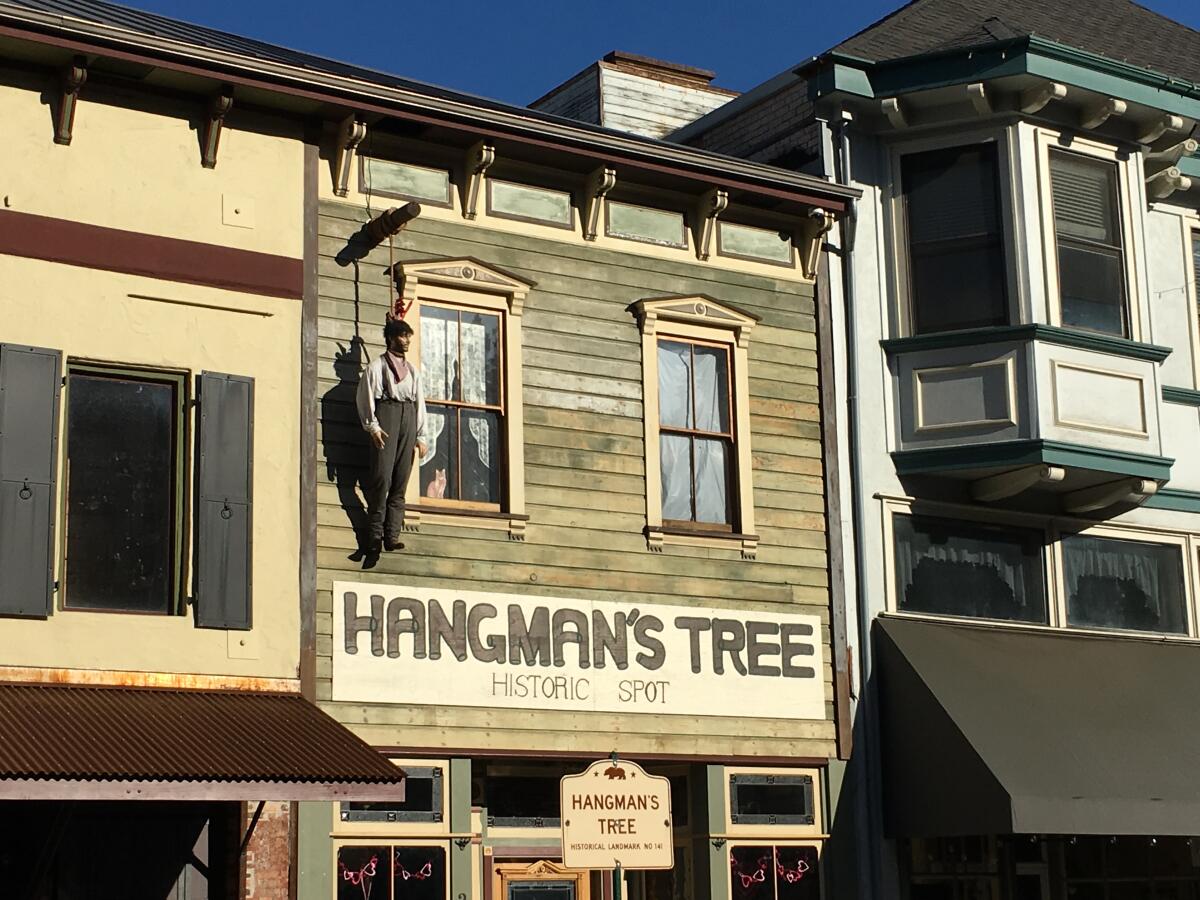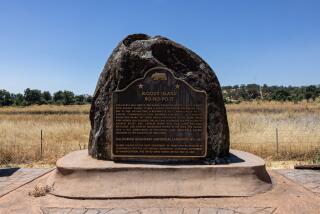Gold Rush past, post-George Floyd present: Placerville drops noose on city logo after months of debate

Behind a man stooping low to pan for gold, a noose hangs from a tree.
“Old Hangtown” boasts the logo of Placerville, Calif. — a reference to its Gold Rush-era moniker.
The Northern California city has been embroiled in a debate for nearly a year over whether to drop the logo’s macabre symbol, which has been equally described as an indelible part of the area’s history and a shameful reminder of it.
City Council members put a period on the heated conversation late Tuesday when they unanimously voted to nix the noose.
Vice Mayor Kara Taylor acknowledged the passions stirred by the issue before making a motion to remove the symbol.
“A lot of people want us to stand up and fight this battle against change,” she said, “but our job at the city is not to fight change but to navigate it.”
Mayor Dennis Thomas said he didn’t think they’d create the same logo today. Growing up in the area with few Black friends, Thomas said the symbol never meant much to him. But after broadening his horizons and listening to others, he said he’s come to see it from another perspective: “If a symbol is this divisive, is it truly worth keeping?”
It’s widely held that the city earned its nickname in 1849 after three men accused of robbery and attempted murder were sentenced to death by hanging. Those men — a Chilean national and two French nationals — spoke no English and were not present at the trial where the death sentence was handed down, according to a history presentation by Brendan Lindsay, an associate professor of history at Sacramento State.
The group of miners who ordered the hangings presented no evidence against the trio “beyond their fitting a general description,” Lindsay said in the presentation prepared at the request of Placerville officials.
More hangings followed.
“Justice in mining camps was typically handled in an extralegal manner, often simply referred to as ‘Judge Lynch,’ ” he added.
A white oak tree at the center of the town was used as a gallows. The stump of that tree, all that remains, sits in the cellar of a bar on Placerville’s Main Street, “named — quite aptly — The Hangman’s Tree,” according to the city’s website. The stump was designated a historical landmark in the 1930s.
A dummy named George hangs from a noose above the second story of the bar. The greeting “Old Hangtown” still welcomes visitors to the city on a large sign along Highway 50.
Calls to remove the city’s nickname — and the imagery associated with it — came last summer shortly after the police killing of George Floyd in Minneapolis sparked widespread racial justice protests. Now the conversation has resurfaced amid the emotional trial of Derek Chauvin, the former officer accused in Floyd’s death.
Council members rejected a redesign that removed the noose in July. They tabled the discussion until January, when they hoped they’d be able to meet in person again.
Scores of people called in to the meeting Tuesday to express their divided opinions, and council members did not weigh in until about 10 p.m.
Those urging the city to “lose the noose” said they weren’t trying to erase local history but rather glorify more worthy aspects — namely ones that don’t evoke violence, death and mob justice.
The logo “should be something that makes us all proud,” caller Annah Rulon said. “We could use that space to represent something beautiful and welcoming.”
But many who want the symbol to stay claimed that revision of their past was exactly what was at stake, couching it as the latest target of “cancel culture.”
Rather than violence or racism, “the noose represents justice,” caller Shea Fuller said, adding, “Justice is more important now I think than it’s ever been. And at the end of the day, that’s exactly what that emblem represents.”
Placerville, the seat of El Dorado County, has about 11,000 residents, nearly 79% of whom are white, according to 2019 census data. Latinos make up about 17% of the city. Less than 1% of the population is Black.
“This moniker glorifies and celebrates a violent and racist history,” Camille Lloyd wrote in a petition to remove “Old Hangtown” from the city’s welcome sign. The petition, launched about 10 months ago, has just over 5,900 signatures.
“Let’s not pretend to be tone-deaf,” she wrote. “The name ‘Hangtown’ is threatening, outdated and offensive, and suggests that racial hate crimes are acceptable.”
A competing petition to keep “Old Hangtown” on the sign launched soon after. Created by Sean Yeske, the opposing petition said calls to remove the name are part of a larger trend to rewrite history in the name of political correctness.
The name “is only offensive to those who read malicious intent into something that is purely historical,” Yeske wrote on the petition, which has upward of 16,560 signatures.
In March, officials decided to gather experts to address Placerville’s history, from its Indigenous roots through the Gold Rush days to the present.
A city report prepared for Tuesday’s meeting shows logos from previous decades that do not include a noose. Officials said they weren’t able to determine exactly when the current logo debuted, but believe it was in the 1970s.
There also has been confusion over the city logo and the city seal, the latter of which does not depict a noose.
It will cost the city over $3,500 to change the logo and remove it from street signs and other locations, in addition to about $1,800 in labor, officials said. Staffers estimate the costs could be absorbed in the city’s current budget.
More to Read
Sign up for Essential California
The most important California stories and recommendations in your inbox every morning.
You may occasionally receive promotional content from the Los Angeles Times.











